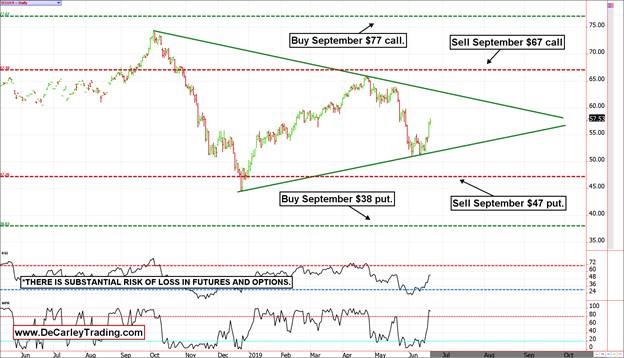Crude oil has been on a wild ride of late. Hear is a strategy to profit from the recent volatility that doesn’t require you to be right on the direction, notes Carley Garner.
Futures trading can be scary to the uninitiated. It involves leverage in fast moving commodity markets. Yet, traders wishing to play in this arena with lower risk and, arguably, better odds of success might look to commodity options. The options markets enable creative traders to build strategies that can be used to express any opinion they might have on price with adjustable degrees of risk and reward. For instance, options traders can construct strategies intended to make money if nothing out of the ordinary happens. Or they can be highly directional plays, but with substantial risk buffers.
Here is an idea on how options strategies can be employed in the current crude oil market. If you wish to participate in something similar, contact your brokerage to ensure they allow option selling strategies, provide reasonable margin rates to do so, and can help you answer questions about risk and reward.
Iron Condors in Crude Oil
The oil market has experienced sharp volatility in recent sessions (actually for several years). As a result, the premium in crude oil options on both sides of the trade appear to be inflated making it possible to sell strangles at relatively distant strike prices. Strangles are employed to make a bet on the direction of volatility, not necessarily the underlying market. With recent high volatility, the price of more distant strikes is relatively high. Implied volatility measures the likelihood the underlying market will move in either direction. In theory, if oil slows down its pace these options should lose value quickly. A trader looking for oil volatility to decline and the futures contract to stabilize could consider selling an Iron Condor using the September expiration options. This is basically a short option strangle with protection; in other words, selling a call option, selling a put option, and then buying a distant call and put for protection. In my view, this provides premium sellers with what appears to be a high-probability venture with potentially substantial, but limited, risk.
Specifically, a trader could consider selling the September $67.00 call and the $47.00 put (a basic short strangle). This gives the market a $20.00 maximum profit range. If at expiration in about 54 days, the price of crude is above $47 and below $67 the trade returns the maximum profit (equivalent to the premium collected). That trader is betting that crude oil will remain within that large range. The same trader could purchase insurance using the September $38.00 put and the $77.00 call option. This protection converts the position to a limited risk venture; however, the risk is still substantial should something go wrong. The maximum loss would occur if oil was below $38.00 or above $77.00 at expiration. This is unlikely in the time frame given, but not impossible.

This spread collects roughly $950 to $1000 in premium, this is the most the trade could make if held to expiration and everything expires worthless. Accordingly, the breakeven on the trade occurs with oil at $46.00 or $68.00 at expiration. At any point between $46.00 and $68.00 the trade makes something and as mentioned, if the futures price is between the strike prices of the options the trade would pay out the entire premium collection.
The protective long options are there to simply mitigate the unlikely tail risk. If the price of crude is above $77.00 at expiration and the trade was held intact the loss would be roughly $9,000. If the price of crude is below $38.00 at expiration the loss would be $8,000. Obviously, this would not be ideal, but it would take a historical move. In short, the long options are simply for catastrophic insurance purposes.
This strategy enables a trader to profit whether the market goes up, down, or sideways. The caveat is that it can’t go above $68.00 or below $37.00. That is plenty of room for error!
While crude oil has exhibited a great deal of volatility over several years, more recently the traditional agricultural commodities have become very interesting. Tomorrow, we will share a potential opportunity in the lean hog market.
*THERE IS A SUBSTANTIAL RISK OF FINANCIAL LOSS IN TRADING FUTURES AND OPTIONS.
DeCarleyTrading.com Futures, Options, Integrity
Click here to open a trading account!
Browse Carley Garner's Trading Education Books
Hear Carley discuss futures at the most recent Las Vega MoneyShow: Carley Garner: How to Trade Futures





















